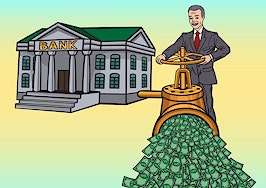Long-term interest rates have broken a narrow, monthlong range and are headed down.
The 10-year Treasury note — the driver of the show — is now 2.23 percent. The lowest-fee mortgages are trying to cross below 4 percent, too.
This is a big move, reinforcing a downtrend. However, this is also a holiday week, markets thin, and November jobs data due next Friday may cancel the whole thing.
But I doubt it. I think the move is real. This is Thanksgiving, so let’s be kind. But the financial press is not doing its job. For whatever reasons, the media is in the thrall of the sunshine boys.
The new U.S. data has been confused by revised third-quarter GDP numbers showing 3.9 percent annual growth — the best 90 days we’ve seen in 11 years.
Unfortunately, those statistics are not validated by anything else.
Home sales — new, old or pending — are flat. The 85-component Chicago Fed National Activity Index never made it above 0.32 in the third quarter (0.7 would amount to something), and retreated to 0.01 in October.
Core orders for durable goods were expected to rise 0.5 percent in October. They fell 0.9 percent. Business capital orders have been off more than 1 percent for two months running. Personal income and spending each gained 0.2 percent in October, but that’s about half the forecast.
No cause for alarm. That depressing string is just soggy, not a contraction. By itself, soggy is not enough to extend the 2014 decline in rates. Look elsewhere for cause.
The rest of the world
Overseas, China cut its policy rate by 0.25 percent this week. This has been widely misunderstood as a stimulus. It’s not. It’s a reaction to cushion an inevitable slowdown that’s already underway.
In Japan, Abenomics is in chaos. Economic reform never began, and the economy fell out from under the first fiscal-repair tax increase. The second has been canceled, and nothing is left but the BOJ hosing cash. The European Central Bank may adopt quantitative easing as early as Friday, but few now trust Draghi’s jawbone. It will be too late, anyway.
German 10-year bonds pay 0.695 percent, Japan’s 0.437 percent. That just screams to investors, “Buy U.S. bonds!” Because in this environment, 2.23 percent is fat.
The Fed is in a pickle. It’s always in one, one way or another, but this one is new.
For the first time since World War II we have reason to doubt the unemployment rate as a signal. The San Francisco Fed this week published an illuminating paper, short and clear.
Since the early 1990s the Fed has used a mathematic rule as the primary guide to setting the federal funds rate, the rate that banks pay for very short-term loans. It’s been close to zero since 2008, after a series of panicky reductions in the fed funds target rate intended to avert a deeper catastrophe.
There are many variables involved in setting the federal funds rate now, but the early model is known as the “Taylor Rule” (after John Taylor, a Fed economist then, now a wildly right-wing tub-thumper at Stanford):
Policy rate = 1.25 + (1.5 * inflation) + or – “output gap.”
In English, you take a base “real rate” (1.25 percent), add a multiple of inflation (the higher inflation, the harder the Fed has to lean), and add to that the degree the economy is running hotter than capacity. Or subtract the degree running under capacity (the “output gap”).
In recent years the economy was so far below capacity that the result of the equation was a negative fed funds rate; at the worst of the Great Recession almost 10 percent negative. That impossible but necessary command to go below zero — you can’t pay banks to borrow money — led to quantitative easing, the Fed’s massive purchases of Treasury bonds and mortgage-backed securities..
We can argue about the 1.25 percent real rate, but it’s OK. We argue about inflation measurements, too. But the core PCE deflator is fair. GDP can under- or overmeasure output in a given quarter (as bloated as it was in the third quarter of 2014), but averaging works.
The problem: To quantify the “output gap,” we must determine variance from potential output. These fed funds equations are cool, but nobody knows how to measure the noninflationary potential output of the economy, except in the rearview mirror — after an inflation or recession accident.
Trying to solve the problem in real time, economist Arthur Okun proposed substituting unemployment for potential. Above 6 percent, too cold; below, too hot. Maybe. Somewhere in there. Used to be.
Okun’s Law is driving the Fed batty. It says the Fed should be above zero right now, while the Taylor Rule still produces a below-zero solution.
Bond traders everywhere are convinced that neither rule applies today. They certainly don’t describe the risk of inflation from running above potential.
Unless the economy accelerates, the Fed will soon have to concede. Buy U.S. bonds!
Lou Barnes is a mortgage broker based in Boulder, Colorado. He can be reached at lbarnes@pmglending.com.



